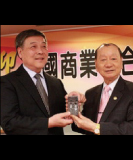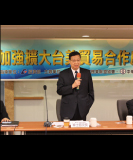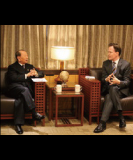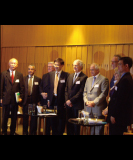You are browsing > Service Trade > Trade Info
On TiSAUSTR
Remarks by Ambassador Michael Froman at the Coalition of Services Industries on the Trade in Services Agreement
Washington. D.C.
June 18, 2014
*As Prepared for Delivery*
For the last several months, I’ve been talking about a trade policy that reflects both our interests and our values: leveling the playing field by strengthening labor and environmental standards around the world, preserving an open Internet that facilitates the free flow of ideas, promoting development through expanded trade and integration.
Whether we’re talking about an internet startup, a corner retailer or a multinational business, we believe in promoting opportunity, in fair and open competition where the best ideas, products and services have the opportunity to make their way to consumers – and where consumers have the chance to buy the things they believe to be the best.
At USTR, our mission is not only to help export goods and services to the world, we are also working to find ways to export these important values.
And that’s what is at the heart of the Trade in Services Agreement.
The Trade in Services Agreement brings together 50 partners, representing 65 percent of the global services market – from the United States, the European Union and Japan, to Costa Rica, Turkey, and Colombia – all recognizing that the world has changed, all convinced that policy needs to respond, all committed to these values.
To put the work in perspective, think about two bits of data.
Since 2009 – the few years since President Obama took office, the count of Internet users has grown from 1.7 billion to 3 billion, nearly half the world’s people. In Africa alone, from 4 million to 172 million. These are people newly connected to the world – interested in everything from World Cup updates to mobile wallets, movies, and m-Health.
And as a result, since 2009, the volume of data crossing the Internet via cable and satellite beam has grown 4-fold, from 11 petabytes to 40 petabytes per month. These are the videos, diagnoses, insurance payments, traffic alerts and news bulletins that are the new world of trade in services.
In effect, container shipping opened the world for manufacturers a half-century ago; the Internet is doing the same for services – and commerce more generally -- today.
Matched with the right policies, this enables us to give home grown businesses the chance to broaden their horizons and create jobs by reaching millions or even billions of new consumers worldwide who are hungry for Made-in America products and services. And this is an extraordinary opportunity in a couple of ways.
First of all, it is an opportunity for American workers, entrepreneurs, and inventors – at a time when we need exports for growth more than ever before.
In 2013, U.S. exports of private services measured nearly $659 billion, and the sale of services through foreign affiliates were nearly $1.3 trillion based on the last yearly numbers available.
Taken together, that means that international sales of services by U.S. companies are approximately $1.8 trillion per year -- an amount equal to approximately 12 percent of the value of U.S. GDP.
Now, that’s an impressive number, but in truth it’s a fraction of what it could be.
In fact, the Peterson Institute estimates that tradable services remain five times less likely to be exported than manufactured products.
When every $1 billion in U.S. services exports support an estimated 5,900 jobs -- the opportunity we have becomes glaringly real for American families and businesses.
Especially because we know that these are good paying, family-wage jobs.
Jobs that can be created in cutting edge-industries like telecommunications, or industrial design, or e-commerce – or health IT and telemedicine, or advertising, or tourism.
Services jobs that are most tradable -- areas like business services – pay on average $56,000 a year. The average annual wage for computer system design services is $110,000. Expanding opportunities for services jobs like these can help strengthen our middle class and address income inequality.
Second, it is just as important an opportunity for new potential buyers – an opportunity for better living standards, for education and arts, even for better health. Here is the World Bank, discussing the implications of mobile wallets – that is, on-line bank accounts maintained through top-class telecommunications and secure financial services – for health care in Africa:
“Programmes like Changamka in Kenya provide patients with pre-paid ‘smart cards’ coded to approve them to receive specific kinds of healthcare at designated health facilities, and can be topped up by M-Pesa or at physical terminals.”
That is a dramatic example of the possibilities services trade offers: on-line bank accounts for people who until two or three years ago had to live by cash and barter; access to health care for people who had none. When we speak of a world in which these services flow freely, we are speaking of better lives for hundreds of millions of people.
So the question becomes an obvious one: what is standing in our way? Why aren’t U.S. exports of services substantially higher? Why are so many individuals still shut out of the systems of telecommunications, finance, health, arts, and education when they are, in theory, so easily and affordably available to the world?
Here in the United States the concept of a level playing field is deeply established, but in other countries we often see a patchwork of discriminatory laws and regulations that curb competition.
One is that restrictions on the flow of data across borders or requirements that companies duplicate their IT infrastructure in a country in order to serve that market makes it harder for companies of all sizes, based in all countries, to compete, and for buyers of all types to connect.
These policies are particularly hard on the increasing number of U.S. small and medium-sized enterprises that now can offer their services online on a global basis.
Small businesses in areas like software development or online retailing get locked out if government rules require them to establish a physical presence in every country.
Let me give you a real-world example of how this works.
I’m sure many of you have gone on-line to look for a particular product and found the retailer with the best price is a tiny shop located in Illinois, or California, or Nebraska.
Now think about how that connection is made? How do you find that retailer?
Well, you find them by using communications and technology services, and you pay for the product using electronic payment services, and then of course the product arrives at your home using delivery services.
In the old days that small retailer relied on the yellow pages and could only hope to serve the local market. But now they can reach across the country to 300 million consumers, and beyond our borders to billions more.
In fact, according to EBay, US commercial sellers that use EBay’s platform to reach foreign markets sell to 19 different countries, on average.
And they aren’t alone. Tomorrow I’m going to be talking with sellers from the website Etsy who are increasingly working to sell their crafts to international consumers. Eighty-eight percent of Etsy’s sellers are women, most of whom run their businesses out of their homes.
But what happens when regulations abroad block advertising content, disrupt search engines, or prevent access to these websites?
What if instead of using the most efficient payment systems, payments have to be channeled through a local bank? Or delivery services have to be routed through a state owned postal monopoly?
You can see how these impediments can build upon each other, adding costs and blocking tiers of buyers at each step, and ultimately become prohibitive.
You can also see from this example how services work together and how protectionist policies can impact retailing, communications, computer, advertising, financial, and delivery services – the chain of services that work seamlessly together to allow the smart-card holder to get her clinic appointment.
These policies make our companies less competitive globally, and when they lose business, we lose jobs.
A second challenge is posed by the role of state-owned enterprises – or “national champions”.
SOEs that benefit from direct and indirect subsidies as well as differences in regulatory treatment may enjoy an advantage that distorts the level playing field. Whether its financial services, telecommunications or delivery services, SOE’s are increasingly playing a significant role. This is an issue we’re taking head-on in TPP, along with other obstacles to the free flow of services, such as regulatory coherence, transparency and good governance.
And a third reason we aren’t living up to our potential is that services trade policy is still new – and in fact, we are only now starting to understand the potential of services trade.
It wasn’t that long ago that services trade was called “invisible trade” by economists.
We have come a long way in the past 20 years since the first international agreement on trade in services (GATS), but still services have a rather low profile. But the world is changing and we can’t afford to wait any longer. And this brings me back to TiSA.
The Trade in Services Agreement is designed to address all of these challenges.
By focusing exclusively on services, we are raising awareness that services are of vital importance, not only as a source of exports but as a driver of competitiveness throughout the economy.
By pursuing ambitious outcomes for market access, we are working to establish a level playing field as the global norm.
And by pursuing common rules of the road in areas like telecommunications, E-Commerce, and regulatory transparency, we are working to minimize policy conflicts and smooth the flow of trade.
In other words, through TiSA we are working to establish state-of-the-art trade rules that promote fair and open competition across a broad spectrum of service sectors.
So let me give you an update on where negotiations currently stand.
TiSA was launched just over a year ago and in that time we have made significant progress.
We are currently engaged with fifty WTO members that represent nearly two-thirds of global trade in services and a combined services market exceeding $30 trillion.
That’s more than half the world GDP.
These participants span the globe – big to small, lower-income to very wealthy. Together they have committed to a vision of the world as it could be in 2020 and 2030: open markets, new opportunities for businesses and for consumers, advances in technological, receding poverty.
The 7th round of negotiations begins next week and the basic framework of the agreement is in place, initial market access offers have been exchanged, and sector-specific work in areas like telecommunications and financial services is in full swing. And we are pleased with the level of progress and the 'can do' spirit of the group.
But we still have a lot of work before us.
We have taken very seriously the calls from business to address new issues in TiSA.
For example, we have tabled an ambitious proposal to address restrictions on cross-border data flows and the troubling trend toward localization requirements.
These issues are difficult, and reaching a consensus will not be easy.
But that is exactly why we need the help of coalitions like “Team TiSA,” which brings together a broad business coalition to help support our efforts.
We need to be making the case to the American public, to businesses, to foreign countries, and to members of Congress that service exports provide an unmatched and untapped opportunity.
An opportunity that TiSA can help us realize.
At USTR, TiSA is a critical component of our overall agenda to unlock opportunity for more Americans, an agenda that also includes negotiations like the Trans-Pacific Partnership (TPP) and the Transatlantic Trade and Investment Partnership (T-TIP).
TiSA is particularly interesting in that it enables us to build a bridge across both the Atlantic and the Pacific – to start working right now on a global basis.
Together, these efforts provide us with a chance to expand the role trade has played over the past 5 years to spur growth during our economic recovery.
Together, our agenda can help our businesses, workers, and families access markets that are hungry for the products and services that only Americans can provide.
As many of you know, there are 525 million middle class consumers in Asia alone today.
By 2030, there are expected to be 2.7 billion middle class consumers in Asia, more than six times the size of what the U.S. market is expected to be at that time.
These consumers will want access to the services that American businesses can provide.
They will want state-of-the-art communications and technology services.
They will want access to high-quality banking, insurance and other financial services.
They will want access to efficient, low-cost logistics and distribution networks – to bring the best products of the world to their door.
They will want to travel the globe, and to enjoy the best of entertainment, games and software services.
The question will be whether we will be there to provide these services?
And the answer will help determine a lot about the job prospects of those in big cities and small towns all across America.
We cannot afford to be left on the sidelines.
We need to move forward together with a Trade in Services Agreement that unlocks opportunity for Americans, and with Team TiSA behind us, I’m confident that we are on the right track.
Thank you.









